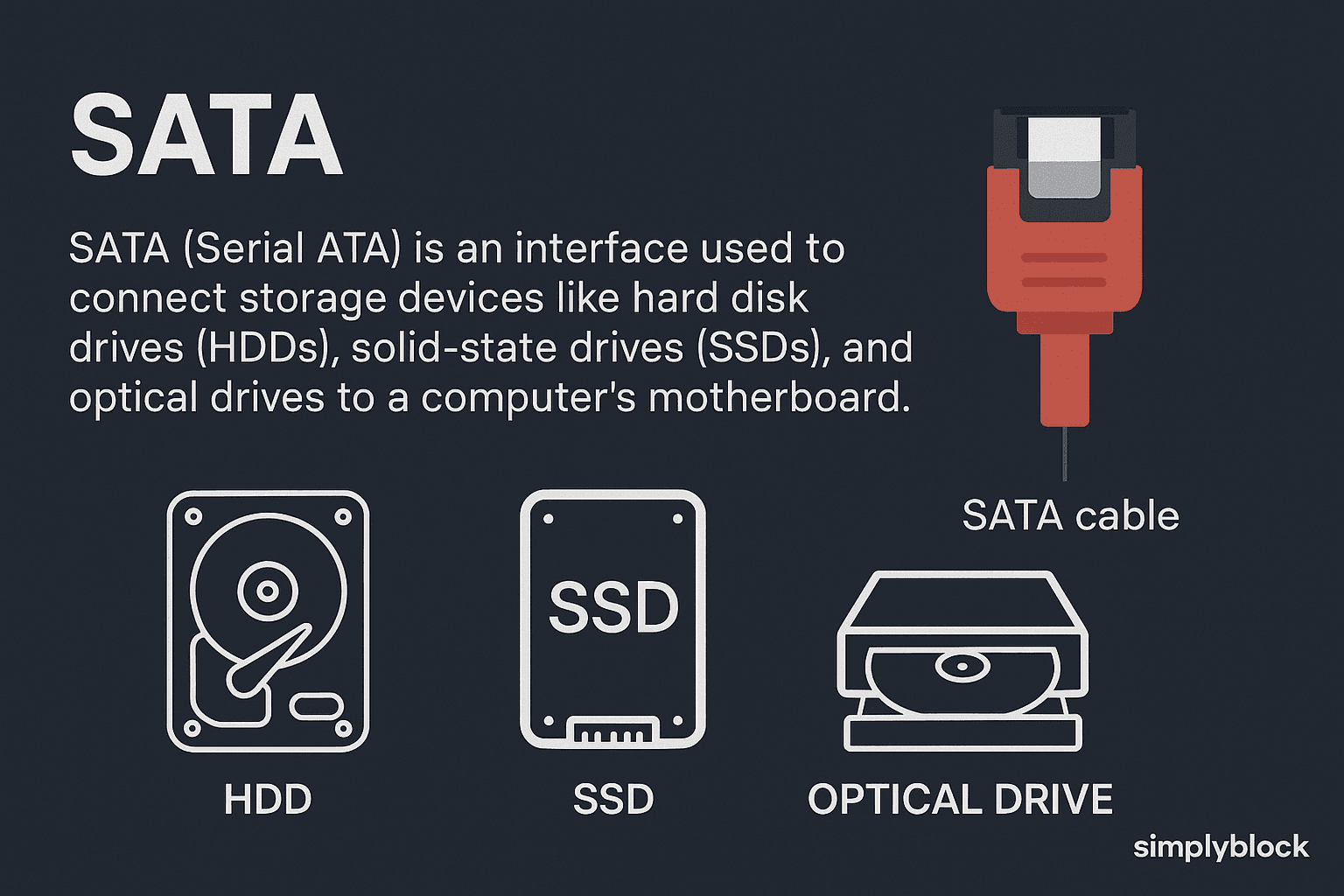SATA
Terms related to simplyblock
SATA (Serial ATA or Serial Advanced Technology Attachment) is a computer bus interface used to connect host systems to mass storage devices, including hard disk drives (HDDs), solid-state drives (SSDs), and optical drives. It replaced the older Parallel ATA (PATA) standard by offering better speed, cable management, and signal integrity.
Despite being eclipsed by faster protocols like NVMe, SATA remains relevant in capacity-oriented environments such as cold storage, backup systems, and hybrid cloud deployments.
How SATA Works
SATA operates over a serial communication channel that requires fewer physical connections than parallel ATA, improving airflow and reducing electrical interference. It supports hot swapping and native command queuing (NCQ), and is available in multiple generations:
- SATA I (1.5 Gbps, ~150 MB/s)
- SATA II (3.0 Gbps, ~300 MB/s)
- SATA III (6.0 Gbps, ~600 MB/s)
The interface connects to the system through SATA controllers on motherboards or host bus adapters, communicating with devices using the AHCI protocol. While widely supported, the AHCI layer adds latency and protocol overhead compared to modern interfaces like NVMe.

Benefits of SATA Storage
While not ideal for high-performance workloads, SATA remains an attractive option in specific use cases due to several key advantages:
- Cost Efficiency: SATA drives offer one of the lowest cost-per-gigabyte metrics, making them ideal for archival and backup storage.
- Low Power Usage: SATA drives, particularly HDDs, consume less energy than high-performance SSDs, helping to reduce operational costs.
- Wide Compatibility: Supported across nearly all operating systems, chipsets, and server platforms.
- Hot-Swap Capable: Drives can be added or removed without downtime, a common requirement in enterprise storage environments.
- Mature Technology: The long-standing ecosystem ensures predictable behavior and easy troubleshooting.
- Optimized for Tiered Storage: In a software-defined architecture, SATA drives serve as a capacity tier beneath NVMe, managed intelligently by the SDS platform.
Modern platforms like simplyblock integrate SATA storage as part of a unified, tiered approach using features like advanced erasure coding and dynamic volume allocation.
SATA vs NVMe – A Practical Comparison
SATA and NVMe are both used in SSDs but differ drastically in performance and architectural efficiency. Here is a side-by-side comparison:
| Feature | SATA (SATA III) | NVMe (PCIe Gen4) |
|---|---|---|
| Max Bandwidth | ~600 MB/s | Up to 7,000+ MB/s |
| Protocol | AHCI | NVMe |
| Latency | 100–500 µs | ~20–30 µs |
| Hardware Interface | SATA controller | PCIe lanes |
| Use Case Focus | Capacity, archival | Performance, real-time workloads |
| TCO | Lower | Higher upfront, lower per IOPS |
Use Cases for SATA in Modern IT
SATA’s cost-effectiveness and reliability make it well-suited for:
- Cold or Warm Data Storage: Ideal for backups, snapshots, and log data.
- Hybrid Cloud Nodes: Where NVMe handles hot data and SATA stores less-frequent access data.
- Edge Deployments: Especially in resource-constrained environments.
- Tiered SDS Platforms: Combining SATA with NVMe to balance cost and performance.
- Capacity-First Workloads: Archival, compliance storage, and offline data warehousing.
SATA in Software-Defined Storage
In the software-defined storage ecosystem, SATA plays a secondary yet critical role. It enables efficient tiering in hybrid architectures, reducing cost per terabyte while NVMe handles latency-sensitive IOPS workloads. Simplyblock™ dynamically places infrequently accessed data on SATA while prioritizing hot data on NVMe, all without manual intervention.
This model supports Kubernetes, cloud-native applications, and legacy VM environments like Proxmox VE or VMware, maintaining optimal cost-performance ratios.
Related Topics
To better understand SATA’s relevance in the broader storage architecture, explore:
- NVMe Over Fabrics
- Hybrid Multi-Cloud Storage
- Kubernetes Persistent Volumes
- Storage Performance Metrics: IOPS vs. Latency
External Resources
- Serial ATA – Wikipedia
- SATA-IO (Serial ATA International Organization)
- AHCI vs. NVMe – Phison Blog
- NVMe vs. SATA: What is the difference? – Kingston Technology
Questions and Answers
SATA (Serial ATA) is a standard interface used to connect hard drives and SSDs to computers and servers. Known for its affordability and wide compatibility, SATA is commonly used for archival, backup, and general-purpose storage where ultra-high performance isn’t critical.
SATA is significantly slower than NVMe over TCP, offering lower bandwidth and higher latency. While SATA is sufficient for cold storage, NVMe is preferred for high-performance workloads like databases, analytics, and real-time applications.
SATA can be used for persistent volumes in Kubernetes, but it’s not ideal for latency-sensitive apps. For containerized workloads that demand performance and scalability, Kubernetes-native NVMe storage is a better fit.
Yes. SATA is often used in storage tiering as a lower-cost, lower-speed layer for cold or infrequently accessed data, while faster tiers (like NVMe) handle active workloads.
SATA drives can support encryption via self-encrypting drives (SEDs) or volume-level encryption at rest. For multi-tenant or regulated environments, storage-layer encryption offers stronger, more manageable protection.
